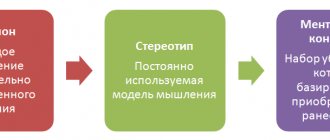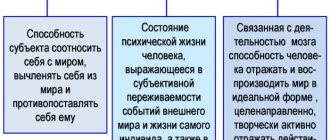- September 6, 2018
- Nervous system diseases
- Valeria Marutkova
You notice that in sudden situations it is difficult for you to overstep your principles and change positions, it is difficult for you to make changes to the usual algorithm of your day, to commit an act unusual for you is nonsense, you do not know how to switch and change your view, it is difficult for you to adapt and get used to change of scenery? These are the first signs of rigidity.
It is worth understanding in more detail what rigidity is in psychology, its types, degrees, and how to get rid of it. Let's start with the most basic, and figure out what it is all about.
What is rigidity?
From Latin the word “rigidity” is translated as “inflexibility, hardness.” On the other hand, the definition of rigidity in psychology is a feature of a person’s thinking that does not allow him to adapt to a new environment, a change of environment, a change in the daily routine, or a change in the behavior program.
A rigid person in his everyday life has a whole set of specific strategies and algorithms for various banal situations or situations that he encounters most often. The strategies in his arsenal are often outdated and do not correspond to the current “standards” of the modern world. But the person using them refuses to accept new ones, following his proven rules, accepted norms and does not allow himself to go beyond the boundaries set by him. The framework that a rigid person sets for himself is perceived as truly true, the only correct and proper one.
As an example of the behavior of a rigid person, we can consider an ordinary situation: imagine a road that you urgently need to cross. The traffic lights and pedestrian crossing are far away, you look around. Good road lighting, excellent visibility, no approaching cars - nothing will prevent a person who does not suffer from rigidity from crossing the road. However, a person with rigid thinking at the moment while an ordinary person is crossing the road will feel an internal obstacle in himself that does not allow him to break the rule, even if it is safe and unpunished, the rigid person will go to the traffic light, perhaps wasting energy on to get there, and the time. Nothing will force him to go beyond the established limits, even if he is in a hurry, misses an opportunity, misses the last plane - the main thing is to follow the established rules.
Story
The concept of cognitive style was first used by A. Adler to denote a personality characteristic, which represents stable individual characteristics of cognitive processes that predetermine the use of various research strategies. Within the framework of his individual psychology, it was understood as the uniqueness of a person’s life path, structured by setting and achieving goals.
G. Allport began to consider cognitive style as an integral personality system of an instrumental order (ways and means to achieve goals). Subsequently, this problem was dealt with by K. Stadner, G. Witkin and others.
In the former USSR, the study of cognitive styles was carried out by V. A. Kolga (Estonia), the Teplov-Nebylitsyn school (Moscow), M. A. Kholodnaya (Kyiv, since the 1990s - Moscow), A. Libin, and others.
A similar concept is metaprograms in NLP. Some of the cognitive styles listed below are at least correlated with the metaprograms described in the literature[1].
Positive aspects of rigidity
As you already understand, rigidity is (from a psychological point of view) a state of a person in which he experiences difficulty or is generally unable to change his usual program of actions. Due to rigidity, any changes in a person’s life are not easily perceived, which greatly affects the individual and her life.
Considering the example of the road, I want to exclaim: “But what’s wrong with a person not breaking the rules? By living by the rules, a person tries to protect himself!” Maybe. By the way, rigidity is not always a bad thing, for example, a person with rigid thinking has increased communication skills, it is easier for him to get along with people, and at work and study the person has obvious success and has organizational skills. And at the same time, such high activity does not prevent him from doing routine or monotonous work, since rigidity increases perseverance.
When an individual's rigidity of thinking is expressed to a small extent, one can notice that this person is neat, punctual, has an accurate goal, his actions are always logical, and he is also stress-resistant.
Cognitive style
Cognitive style (from Latin cognitiо - knowledge and Greek stylos - lit. writing rod) is a term used in cognitive psychology to designate stable characteristics of the way different people think, perceive and remember information, or their preferred way of solving problems .
Cognitive style is usually distinguished from cognitive ability or level - the latter is measured by so-called intelligence tests. There is still disagreement about the meaning of the term “cognitive style.” However, the term "cognitive style" is widely used, especially in applied psychology (business, as well as educational psychology, where the term cognitive style has a synonym - "learning style").
The concept of cognitive style was first used by A. Adler to denote a personality characteristic, which represents stable individual characteristics of cognitive processes that predetermine the use of various research strategies. Within the framework of his individual psychology, it was understood as the uniqueness of a person’s life path, structured by setting and achieving goals.
G. Allport began to consider cognitive style as an integral personality system of an instrumental order (ways and means to achieve goals). Subsequently, this problem was dealt with by K. Stadner, G. Witkin and others.
In the former USSR, the study of cognitive styles was carried out by V. A. Kolga (Estonia), the Teplov-Nebylitsyn school (Moscow), M. A. Kholodnaya (Kyiv, since the 1990s - Moscow), A. Libin, and others.
Most often, about 10-15 cognitive styles are considered in the literature (it is noted that many of them obviously correlate with each other, and the difference in terminology is due to the approaches of different authors:
- field independence - field dependence;
- concreteness - abstractness;
- narrow—wide range of equivalence;
- narrowness—breadth of the category;
- rigid—flexible cognitive control;
- low - high tolerance to unrealistic experience;
- focusing - scanning control;
- smoothing - sharpening;
- impulsiveness - reflectivity;
- cognitive simplicity - complexity;
- others (Myers-Briggs questionnaire scales, NEO PI-R, etc.
Links
- T. V. Kornilova, G. V. Paramei. Approaches to the Study of Cognitive Styles: Twenty Years Later
- Leaver B.L. Methods of individualized teaching of a foreign language, taking into account the influence of cognitive styles on the process of its acquisition. Dissertation for the degree of candidate of pedagogical sciences, State Institute of Russian Language named after. A.S. Pushkin, Moscow, 2000
- Seminar on cognitive styles
- https://tip.psychology.org/styles.html
- https://www.personality-project.org/perproj/others/heineman/cog.htm
Literature
- Egorova M. S. Psychology of individual differences. M., 1997.
- Klimov E. L. Individual style of activity depending on the typological properties of the nervous system, Kazan: KSU, 1969.
- Cognitive styles. Abstracts of a scientific and practical seminar (ed. V. Kolga), Tallinn, 1986.
- Libin A.V. Differential psychology. M.: Smysl, 1999.
- Leaver B. L. Teaching the whole class. Novosibirsk, 1994.
- Psychological problems of individuality, issue 1. M.; L., 1983.
- Abilities and inclinations (edited by E. A. Golubeva). M.: Pedagogy. 1989.
- Person's style; psychological analysis (edited by A. V. Libin) M.: Smysl, 1998.
- Tolochek V. L. Activity styles: A model of styles with changing conditions of activity. M., 1992.
- Kholodnaya M. A. Cognitive styles. M. 2004.
- Shkuratova I.M. Cognitive style and communication. Rostov n/d.: Publishing house Rost, ped, university, 1994.
- Allinson, C. W., and Hayes, J. “The cognitive style index: a measure of intuition-analysis for organizational research,” Journal of Management Studies (33:1), January 1996, pp. 119–135.
- Atherton, J. S. "Learning and Teaching: Pask and Laurillard", 2003. Retrieved 28 June 2003, from https://www.dmu.ac.uk/~jamesa/learning/pask.htm#serialists.
- Beiri, J. "Complexity-simplicity as a personality variable in cognitive and preferential behavior" Dorsey Press, Homewood, IL, 1961.
- Bobic, M., Davis, E., and Cunningham, R. “The Kirton adaptation-innovation inventory,” Review of Public Personnel Administration (19:2), Spring 1999, pp. 18-31.
- Carey, J. M. "The issue of cognitive style in MIS/DSS research", 1991.
- Kirton, M. “Adaptors and innovators: a description and measure,” Journal of Applied Psychology (61:5) 1976, pp. 622–629.
- Kirton, M.J. "Field Dependence and Adaptive Innovation Theories", Perceptual and Motor Skills, 1978, 47, pp 1239-1245.
- Kirton, M. J. Adaptation and innovation in the context of diversity and change Routledge, London, 2003, P. 392
- Mullany, M.J. "Using cognitive style measurements to forecast user resistance", 14th Annual conference of the National Advisory Committee on Computing Qualifications, Napier, New Zealand, 2001, pp. 95-100.
- Peterson, E. R., & Deary, I. J. (2006). Examining wholistic-analytic style using preferences in early information processing. Personality and Individual Differences, 41, 3-14.
- Pask, G. “Styles and Strategies of Learning,” British Journal of Educational Psychology (46:II) 1976, pp. 128–148.
- Riding, R. J., and Cheema, I. “Cognitive styles—An overview and integration.” Educational Psychology (11:3/4) 1991, pp. 193–215.
- Riding, R. J., and Sadler-Smith, E. “Type of instructional material, cognitive style and learning performance.” Educational Studies (18:3) 1992, pp. 323–340.
- Witkin, H. A., Moore, C. A., Goodenough, D. R., and Cox, P. W. “Field dependent and field independent cognitive styles and their educational implications,” Review of Educational Research (47:1), Winter 1977, pp. 1–64.
Disadvantages of Rigidity
But rigidity has many more disadvantages. With pronounced rigidity, the person becomes narcissistic and very conflicted, and passion for some activity or hobby is put at the forefront of activities, overshadowing everything else. Most often, these signs appear in patients with mental illness.
In a situation where rigidity is expressed to an extreme degree, the person, on the contrary, is observed to be careless and irresponsible. Excessive activity alienates others, and most do not understand the ardent desire to achieve a goal.
Increased rigidity is most often accompanied by emotional instability and paranoia. Individuals are susceptible to obsessions, sometimes overly aggressive and unable to establish contact with the outside world.
In life, mental rigidity prevents a person from being simply happy, since he often does not allow himself small pleasures, considering short-term desires a waste of time and effort.
Degree of rigidity, symptoms
There is no need to worry in vain; rigidity is common to all people. Its certain degree is inherent in everyone and is explained by the fact that the human psyche tends to create and get used to a certain pattern of actions in order to save strength and energy, and the established patterns are reinforced by the paths of neural connections, which allows a person to do monotonous work (knitting, for example), and think about friend (watch TV and knit).
The degree of severity of rigidity is individual for everyone and depends on the characteristics of the individual. So, some people are predisposed to rigidity due to their nature, and for some, despite many factors, its manifestations remain minimal.
The degree of rigidity can be determined by observing several situations, since the reaction due to personality characteristics may be different and rigidity will manifest itself to varying degrees. There is a small list of situations, considering the behavior in which you can assess the extent of the problem:
- the complexity of the task set to be achieved;
- danger level;
- the presence or absence of motivation to achieve the goal;
- variations of extreme situations.
It is a big mistake to mistake integrity for rigidity. In the case of the second, the person can step over the principles and easily adapts to a new situation, easily adapts to a new society and environment.
Definition
Cognitive flexibility can be seen from different perspectives. The study's synthesized definition of cognitive flexibility is a change in thinking , whether it is based specifically on changing rules or more generally on the need to switch one's previous beliefs or thoughts to new situations. Moreover, it refers to considering multiple aspects of thinking simultaneously, whether two aspects of a particular object or multiple aspects of a complex situation.
Important! Other terms and components of cognitive flexibility include mental flexibility, mental set shifting, cognitive shifting, task shifting, and attention shifting.
Cognitive flexibility varies throughout a person's life. Researchers have more specifically described cognitive flexibility as the ability to shift one's thinking and attention between different tasks, usually in response to changing rules or demands. For example, when sorting cards based on specific rules, children are considered cognitively flexible if they can successfully switch from sorting cards by the color of an object to sorting by the type of object on the card.
Cognitive flexibility is more broadly described as the ability to adapt one's thinking from old situations to new situations , as well as the ability to overcome habitual responses and adapt to new situations. Thus, if someone is able to overcome pre-existing beliefs or habits (when required for new situations), then they will be considered cognitively flexible. Finally, the ability to simultaneously consider two aspects of an object, idea, or situation at one point in time is related to cognitive flexibility. According to this definition, when sorting cards based on certain rules, children are considered flexible cognitively if they can sort cards by the color of the items and the type of items on the card at the same time. Similarly, cognitive flexibility is defined as having an understanding of all possible options and alternatives simultaneously in any given situation.
Contributing Factors
Regardless of the specifics of the definition, researchers generally agree that cognitive flexibility is a component of executive functioning, a higher-order cognition that involves the ability to control one's thinking. Executive functioning includes other aspects of cognition, including memory, emotional stability, planning, and organization. Cognitive flexibility is closely related to a number of these abilities, including inhibition, planning, and working memory. Thus, when a person is better able to suppress aspects of a stimulus in order to focus on more important aspects, they also become more cognitively flexible. In this sense, they are better at planning, organizing, and using specific memory strategies.
The researchers argue that cognitive flexibility is also a component of multiple categorization, as originally described by psychologist Jean Piaget. In several tasks, participants (primarily children who have already developed or are in the process of developing this skill) must categorize objects in several different ways at the same time—thinking about them flexibly. Likewise, to be cognitively flexible, they must overcome concentration, which is the tendency for young children to focus exclusively on one aspect of an object or situation. For example, when children are young, they may only focus on one aspect of an object (i.e., the color of the object) and may not be able to focus on both aspects (i.e., the color and type of the object).
Important! Research shows that if a person is focused on their thinking, they will be more cognitively inflexible.
Cognitive flexibility is related to other cognitive abilities such as intelligence, reading fluency, and reading comprehension. Fluid intelligence, described as the ability to solve problems in new situations, provides the ability for logical reasoning. When a person is able to reason fluidly, they are, in turn, more prone to cognitive flexibility . Additionally, those who are capable of cognitive flexibility have been shown to be able to switch between sounds and meanings and/or think about them simultaneously, which improves reading fluency and comprehension. Cognitive flexibility has also been shown to be related to a person's ability to cope with specific situations. For example, when people are better able to shift their thinking from situation to situation, they will focus less on the stressors in those situations.
In general, researchers in this area focus on the development of cognitive flexibility between the ages of three and five. However, cognitive flexibility has been shown to be a broad concept that can be studied at any age and in different situations. Thus, with tasks ranging from simple to more complex, research suggests that there is a continuum of development that extends from infancy to adulthood.
Types of rigid thinking
There are three main types of rigidity of thinking:
- Cognitive. The most common type of rigidity. This type relies on sensory cognition and the ability to perceive new information. Cognitive rigidity is expressed in the inability to create a new concept or learn new information. A dissonance occurs in the individual’s head between established, ingrained views and new information, which is why the individual begins to distance himself from the team and close people, trying to close himself off from the new world.
- Motivational. The individual refuses to accept new motivations for action and cannot complete subsequent tasks. Most often, such rigidity can be seen in situations where a person does not perceive new reasons to satisfy any needs, or refuses to get rid of something because it has become a habit. In the background, highly valuable ideas can develop.
- Affective. Rigidity manifests itself in the comparison of situations and the emotional response to it. The individual is too carried away by the chosen object or certain conditions.
Cognitive simplicity and cognitive complexity
From a theoretical point of view, the basis of cognitive simplicity and cognitive complexity can be called D. Kelly’s theory of personal constructs. The predominance of someone's style can be determined by measuring the simplicity or complexity of a complex of personal constructs in the process of interpretation, prediction and analysis of the surrounding reality, based on subjective experience organized in a specific way.
Here, constructs should be understood as a bipolar subjective measurement scale, which plays the role of a way to establish similarities or differences in the process of perception. These styles are diagnosed using the repertory grid method developed by D. Kelly.
In addition to the cognitive styles discussed above, which can be considered basic, some others can also be distinguished, for example, the figurative-effective style of interpreting information, due to the leading role of the right hemisphere of the brain; verbal-logical style of interpreting information, in which the leading role is given to the left hemisphere, and some others. To diagnose each style, specialists use various test methods.
YOUR COGNITIVE STYLE: Despite the fact that, as was said, a lot of different methods are used to establish a person’s leading cognitive style, there are special test materials that allow you to determine with maximum accuracy which cognitive style a particular person belongs to. Today you can test for yourself how such materials work, and at the same time establish your own cognitive style. This is exactly what we invite you to do - we invite you to take our course on self-knowledge (you can find it here), and learn a lot of new things not only about the nuances of your perception, but also about other features of your personality.
We wish you good luck and success!
We also recommend reading:
- Storytelling
- Leadership styles according to life cycle theory
- Fred Fiedler's Model of Effective Leadership
- Vroom, Yetton and Iago decision making model
- Thinking styles Boncheck and Steele
- Herzberg's two-factor theory of motivation
- Roger Shepard test
- Learning styles
- Cognitive psychology and cognitive psychotherapy
- “I-concept”: characteristics, features, meaning
- Combinatorial thinking
Key words:1Cognitive science
Features of a rigid person
You can independently identify a person who is rigid or prone to this. There are several properties common to all three types. For example:
- stubborn character;
- inability to give up a habit;
- impressionability;
- inability to change one's behavior on one's own.
At the same time, a person with rigid thinking may exhibit contradictory properties:
- overly sociable, trying to stand out or be the center of attention;
- grumpy, devalues the world around him, dissatisfied and filled with negativity;
- skeptic;
- withdraws from society;
- evil joker, makes fun of people.
If you want to determine whether you are a rigid person and what degree of rigidity you have, analyze your behavior or ask your loved ones about it.
Narrowness and breadth
This implies the narrowness and breadth of the range of equivalence. Such cognitive styles characterize individual characteristics on the scale used by a person when evaluating the differences and similarities of objects.
Some people, when randomly classifying, can divide objects into many groups with a small volume of objects (this is a narrow range), while others - into a smaller number of groups with a large volume of objects (this is a wide range).
The basis of these differences is mainly the level of “sensitivity” to established differences and the focus on establishing differences of different types. A person with a narrow range of equivalence relies on the physical properties of objects, and a person with a wide range relies on hidden additional properties. Some domestic experts characterize the first style as analytical, and the second as synthetic. A connection has also been established between analytical and synthetic cognitive styles with personality characteristics.
How to deal with rigidity of thinking?
How to deal with rigidity? The first person to talk about the inability to make changes in attitudes and activities when the situation changes is Jacob Moreno, who correctly added that rigidity is the scourge of the twentieth century.
Why? The problem is that in an industrial society and with the flourishing of well-functioning mechanisms, in bureaucratic states it was precisely the rigid person who became especially necessary - a person capable of carrying out everything strictly according to instructions, which greatly influenced civilization in the future.
Moreno concluded that the people were being “shredded.” There are few people left who dare to doubt the instructions, so in the fight against rigid thinking, Moreno prescribed two pills: spontaneity and creativity.
Footnotes and sources
- Hall M., Bodenhamer B. 51 NLP metaprograms. - M.: Prime Euroznak, 2007. - 352 pp. - ISBN 5-93878-198-1
- ↑ 1 2 Shkuratova I.P.
Cognitive style and communication. Rostov-on-Don: Publishing house of the Russian State Pedagogical University, 1994.156 p. - ↑ 1 2 Witkin H., Goodenough D.
Cognitive style: essence and origins. NY 1982. 135 p. - [irshkuratova.ru/files/pl017.pdf Shkuratova I.P.]
[irshkuratova.ru/files/pl017.pdf Cognitive styles as regulators of a person’s worldview]
"Wittgenstein's ladder"
It sounds simple, but in reality it is very difficult to get rid of rigid thinking and you should contact a specialist who will create an individual treatment program for you.
The problem with rigidity is that no matter how much the patient wants to get rid of the desire to follow the rules, his inner “I” protests. The subconscious convinces him that by overstepping his rules, a person will turn into an unprincipled person, capable of any base act.
Patients who have overcome their rigidity say that in reality it turns out that there was no rigidity, only honor, integrity, beliefs and faith in traditions on an inflated scale.
To convince yourself to get rid of the belief in the correctness of your actions, repeat to yourself that truth is a relative concept; you may have misunderstood it when you heard or read it. Are you sure that your actions, actions and their motives are the truth? And in our impermanent world, is it possible to be sure that the truth remains and is understood in the same way as it was an hour, a day, a month ago?
Convince yourself that truth is unknowable.
Accept for yourself and come to terms with “Wittgenstein’s ladder”, which sounds like this:
The original order is like a ladder that is used to climb somewhere. However, after this the ladder must be discarded. Because it turns out that although it was useful, it itself had no meaning.
Links
- [psylab.info/Category:Diagnostics_of_cognitive_styles Methods for diagnosing cognitive styles] (inaccessible link since 05/13/2013 (2705 days))
- [www.voppy.ru/issues/1989/896/896140.htm T. V. Kornilova, G. V. Paramei. Approaches to the Study of Cognitive Styles: Twenty Years Later]
- [www.socioniko.net/ru/articles/DISS.pdf Leaver B. L. Methods of individualized teaching of a foreign language, taking into account the influence of cognitive styles on the process of its acquisition. Dissertation for the degree of candidate of pedagogical sciences, State Institute of Russian Language named after. A. S. Pushkina, Moscow, 2000]
- [www.voppy.ru/issues/1986/865/865187.htm Seminar on cognitive styles]
- tips.psychology.org/styles.html
- www.personality-project.org/perproj/others/heineman/cog.htm










